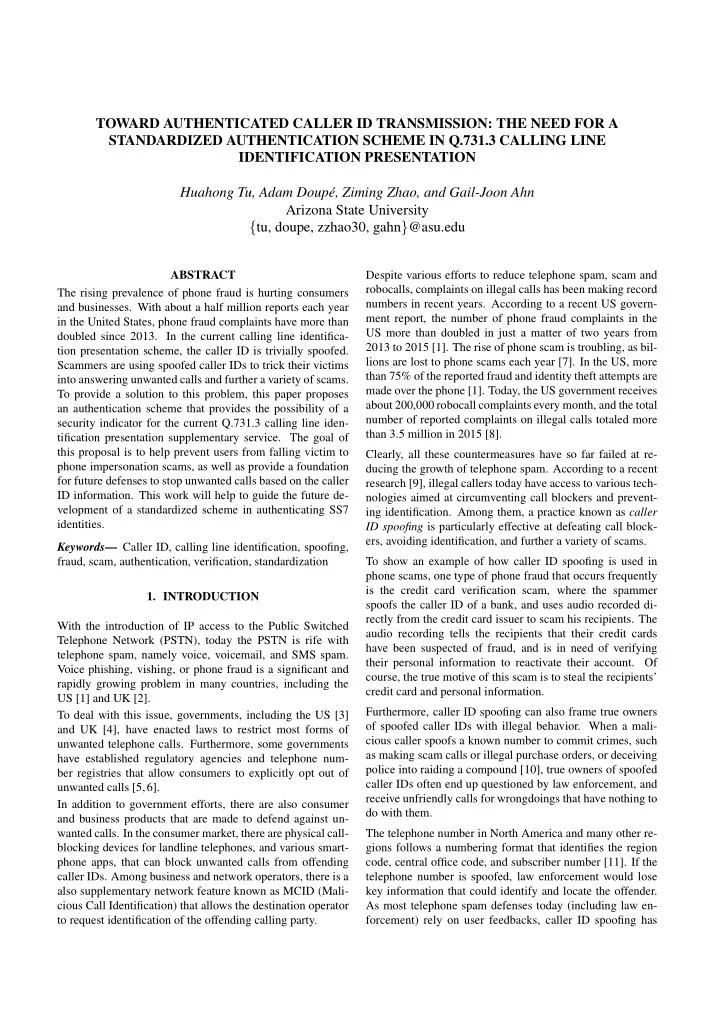

TOWARD AUTHENTICATED CALLER ID TRANSMISSION: THE NEED FOR A STANDARDIZED AUTHENTICATION SCHEME IN Q.731.3 CALLING LINE IDENTIFICATION PRESENTATION Huahong Tu, Adam Doup´ e, Ziming Zhao, and Gail-Joon Ahn Arizona State University { tu, doupe, zzhao30, gahn } @asu.edu ABSTRACT Despite various efforts to reduce telephone spam, scam and robocalls, complaints on illegal calls has been making record The rising prevalence of phone fraud is hurting consumers numbers in recent years. According to a recent US govern- and businesses. With about a half million reports each year ment report, the number of phone fraud complaints in the in the United States, phone fraud complaints have more than US more than doubled in just a matter of two years from doubled since 2013. In the current calling line identifica- 2013 to 2015 [1]. The rise of phone scam is troubling, as bil- tion presentation scheme, the caller ID is trivially spoofed. lions are lost to phone scams each year [7]. In the US, more Scammers are using spoofed caller IDs to trick their victims than 75% of the reported fraud and identity theft attempts are into answering unwanted calls and further a variety of scams. made over the phone [1]. Today, the US government receives To provide a solution to this problem, this paper proposes about 200,000 robocall complaints every month, and the total an authentication scheme that provides the possibility of a number of reported complaints on illegal calls totaled more security indicator for the current Q.731.3 calling line iden- than 3.5 million in 2015 [8]. tification presentation supplementary service. The goal of this proposal is to help prevent users from falling victim to Clearly, all these countermeasures have so far failed at re- phone impersonation scams, as well as provide a foundation ducing the growth of telephone spam. According to a recent for future defenses to stop unwanted calls based on the caller research [9], illegal callers today have access to various tech- ID information. This work will help to guide the future de- nologies aimed at circumventing call blockers and prevent- velopment of a standardized scheme in authenticating SS7 ing identification. Among them, a practice known as caller identities. ID spoofing is particularly effective at defeating call block- ers, avoiding identification, and further a variety of scams. Keywords — Caller ID, calling line identification, spoofing, To show an example of how caller ID spoofing is used in fraud, scam, authentication, verification, standardization phone scams, one type of phone fraud that occurs frequently is the credit card verification scam, where the spammer 1. INTRODUCTION spoofs the caller ID of a bank, and uses audio recorded di- rectly from the credit card issuer to scam his recipients. The With the introduction of IP access to the Public Switched audio recording tells the recipients that their credit cards Telephone Network (PSTN), today the PSTN is rife with have been suspected of fraud, and is in need of verifying telephone spam, namely voice, voicemail, and SMS spam. their personal information to reactivate their account. Of Voice phishing, vishing, or phone fraud is a significant and course, the true motive of this scam is to steal the recipients’ rapidly growing problem in many countries, including the credit card and personal information. US [1] and UK [2]. Furthermore, caller ID spoofing can also frame true owners To deal with this issue, governments, including the US [3] of spoofed caller IDs with illegal behavior. When a mali- and UK [4], have enacted laws to restrict most forms of cious caller spoofs a known number to commit crimes, such unwanted telephone calls. Furthermore, some governments as making scam calls or illegal purchase orders, or deceiving have established regulatory agencies and telephone num- police into raiding a compound [10], true owners of spoofed ber registries that allow consumers to explicitly opt out of caller IDs often end up questioned by law enforcement, and unwanted calls [5,6]. receive unfriendly calls for wrongdoings that have nothing to In addition to government efforts, there are also consumer do with them. and business products that are made to defend against un- wanted calls. In the consumer market, there are physical call- The telephone number in North America and many other re- blocking devices for landline telephones, and various smart- gions follows a numbering format that identifies the region phone apps, that can block unwanted calls from offending code, central office code, and subscriber number [11]. If the caller IDs. Among business and network operators, there is a telephone number is spoofed, law enforcement would lose also supplementary network feature known as MCID (Mali- key information that could identify and locate the offender. cious Call Identification) that allows the destination operator As most telephone spam defenses today (including law en- to request identification of the offending calling party. forcement) rely on user feedbacks, caller ID spoofing has
Recommend
More recommend